Do Sea Wolf Subs and Battling Brass – Make Tsunamis Come to Pass?
by Trowbridge H. Ford … edited by Jim W. Dean
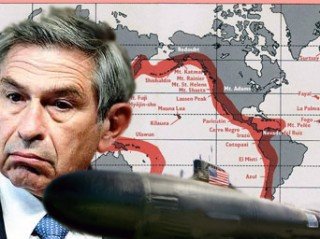
The Pentagon, especially Deputy Secretary Paul Wolfowitz and Chief of Naval Operations Vern Clark, were most concerned about the cause, scope, and consequences of the December 26, 2004 Indian Ocean tsunamis because they were far bigger and more destructive than they had anticipated.
More important, it had no clear alibi that their most likely source of the disaster, the Multi-Mission Platform of the new stealth attack submarine, the USS Jimmy Carter, had not been the culprit.
Its behavior – ever since Admiral Clark had given it a most spirited send-off during the previous September from its home base at Groton, Connecticut for its testing until it returned in February 2005 for the official commissioning – had called for the most clumsy coverups, deceptions, and dishonesty.
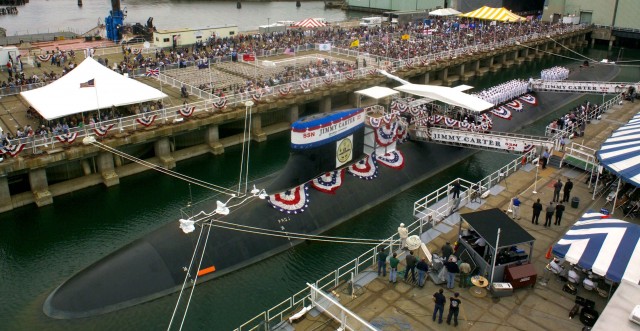
The earthquakes on the fatal day had confounded all expert opinion about such events. While it acted as if they were just the most destructive of natural disasters, there was nothing natural about them.
Most uncharacteristically, there had been no warnings of the massive collapses in the Sumatran Trench, once the Australian-Indian plate had been broken loose from its base on the Antarctic one.
This was the most stable one in the world, and breaking its connection to the one to the north with the 8.2 earthquake on December 24th by means apparently of air guns deposited on the bottom from the Carter, set off a shaking of the whole plate northwards which became so powerful – the power of 25,000 Hiroshima-style atomic bombs – that it was simply propelled through the Burmese one it was touching to the west of Sumatra.
The Australian-Indian plate had been converted into an underground, flying saucer.
To forestall any sensible conspiracy theories about this devastating plot, Joe Vialls immediately concocted a most intriguing but essentially wrong explanation of it all.
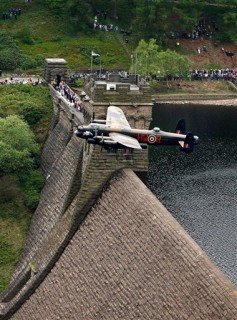
In it, “Tsunami result of U.S, nuclear bomb?”, the king of conspiracy theories said that Wolfowitz had done it all, but it was not by causing an earthquake but by using a devastating wall of water with something like a 9-megaton W-53 thermonuclear bomb – like what the British “Dambusters” had done during WWII -dropped probably from the stern of some oil rig supply vessel plowing the busy waters.
The purpose, as the covert behavior of two American battle groups, steaming to the area from Hong Kong and Guam, demonstrated, was simply to take over the oil rich province of Aceh.
While Vialls was totally wrong about the cause, unfolding, and purpose of the disaster, he rightly left little doubt about who was responsible for it: “…it would seem that the only realistic candidates are Wolfowitz and company, striving as always to create a ‘One World Government’.”
Vialls went on to accuse the Deputy Secretary of being behind an e-mail he received which claimed that Houston was going to be attacked by a nuclear bomb at the same time – apparently to distract people from what was going on in the Indian Ocean.
This gross piece of disinformation had the desired effect of giving Wolfowitz an alibi for the disaster, and stopping all reasonable speculation about what really happened on December 26th.
There is no evidence of a nuclear explosion off Aceh, of the USA taking over territory in its imperial pursuits, or that it did so in this case.
The whole basis of American ambitions was to take over countries through bases at important points, get them to adopt trade policies which benefit Washington, and go along with its strategy of preventive wars to build the kind of world it wants.
The best example of this is the U. S. base in Diego Garcia, what the U. K. has allowed Washington to make into a full-blown naval base, being warned by the Pacific Warning Centre of the earthquakes and likely tsunamis.

Wolfowitz and the Pentagon still had to be worried about blow back because of the Carter’s activities.
When it was leaving Groton in September 2005, CNO Clark had dropped by to wish it well as it took off for its first tests, and operations south of Australia and New Zealand.
According to an official source, he told the excited but untested crew:
“This is what tomorrow is about for the U.S. Navy – the ability to project credible combat power to the far corners of the earth, giving the president options, around the world and around the clock.” (“Silent Service Ebbs Uncertainty In Groton Submarines: Role Being Reduced To Fit In With New, Leaner Military’,” The Hartford Courant, May 22, 2005)
It could not have gotten a better endorsement for its risky, nail-biting mission.
Little wonder that when the Carter finally returned in triumph to Connecticut, probably in late January, it let it all hang out, sporting a new broom from the front of its conning tower, showing that it had swept the Indian Ocean clean of potential enemies.
![Carter_Tower]](https://www.veteranstodayarchives.com/wp-content/uploads/2011/09/Carter_Tower-320x228.jpg)
Showing the broom was the traditional way submarines showed that they had accomplished a “clean sweep” of enemy vessels during wartime when they returned to home base – what had not been done in alleged peacetime until recently, it seems, and, anyway, America – as President Bush had declared after the 9/11 attacks – was at war.
Of course, its mixing of testing and missions completely wrecked its scheduled tests. making them occur later than SOP dictated, if they really occurred at all.
The biggest problem had been showing the broom, and admitting when it occurred, especially if it had happened before the scheduled Alpha Tests. Besides, showing the real photographs of the returning sub in triumph might just have been so celebratory and big to pass unnoticed.
So the Navy had another sub, quite possibly the USS Toledo – showing that it too had made a “clean sweep” of the enemy aka Kursk when it returned to Groton back in 2000 – stand in its stead for the official photos of its alleged completion of the Alpha ones on November 19th.
The USS North Carolina, the latest submarine in the Virginia class, later caused a fury of controversy when it followed apparently the precedent set by the Carter by showing a “clean sweep” with the broom when it just returned to Groton from its Alpha trials.
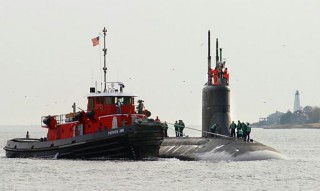
The photos show that the sub, showing the broom, is quite clearly not the Carter but a much smaller, quite used submarine – what obliged the Navy to crop down one photo of the returning heroes so its quite used, smaller conning tower is seen as little as possible, and the other has a convenient tugboat hiding its much shorter length.
Also, note that these two photographs are conveniently separated from the ones actually of the Carter to make serious comparisons more difficult.
The other photographs, especially of the commissioning of the Carter, are just as disturbing with those actually of the submarine being taken so as to play down its size, especially its length, and those of the commissioning party, especially former President Carter, and Vice President Walter Mondale, and their wives being nowhere in sight.
As for officials of the previous Bush administration, none of them, it seems, attended. The Carter, apparently for the reasons indicated, had suddenly become something few wanted to acknowledge even the existence of, much less celebrate.
It was also on February 7th – just between when the Carter finally went on its final sea trials, and its commissioning – that CNO Clark surprisingly announced that he would be stepping down in July.
The normal term of a CNO is five years, and Clark had already been asked by Rumsfeld about a year and a half before – when the most ambitious plans for the sub were being drawn up – to extend his tenure at least until the end of 2006, cutting short his tenure by a year and a half.

“It’s really not about me,” the Admiral most disingenuously explained, “It’s about the institution.” To add to the disbelief, Clark said it was time for new blood to lead the Navy – what would undoubtedly lead to an Annapolis graduate chief, officers Clark had no confidence in.
As Bob Woodward has explained in Bush at War, Part III: State of Denial, “Clark was one of the most improbable men to lead the Navy. Unlike 25 of his 26 predecessors, he was not a ‘ring-knocker,’ a graduate of the U. S. Naval Academy in Annapolis, Maryland…He had gone to officer candidate school in 1968 at the height of the Vietnam War.
He had quit in 1972 after his first tour of duty because he did not respect most of the officers who were making the Navy a career, but he rejoined the following year, believing the Navy was something he should do for a while.” (p. 39)
It was by bucking the system that Clark finally became CNO after Admiral Jay Johnson in 2000, thanks to the input provided by SOD William Cohen, his civilian superior. He had asked Clark why Navy affairs were so screwed up.
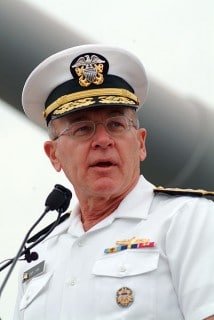
“They picked the wrong people,” (ibid., p. 60) Clark replied. Of the top five admirals in the Navy, only one had ever commanded a carrier battle group. The others were usual desk admirals.
When Clark was in the running to become Chairman of the Joint Chiefs, he told Vice President Dick Cheney later: “Whatever you do, don’t let it get like that again.”
Things were so bad after Clark’s tenure as CNO that the President did just this – appointed Admiral Mike Mullen – a desk admiral who was also connected to the long-running scandal at the Naval Academy, his alma mater – as his successor.
When Mike Boorda, the only other chief who had risen through the ranks to the top, was CNO, he became so involved in controversy and scandal that he ended by killing himself.
John Lehman, Jr., a former Navy Secretary in the Reagan administration, blamed Boorda’s suicide upon the media, led by self-serving politicians in the Clinton administration. The Bush administration was so troubled by its affairs that it was willing to take the risk.

Things, though, got even worse in this regard a few months later when Clark called for the elimination of the whole submarine base at New London, and its residents were up in arms about the turnabout, as The Hartford Courant explained: “Adm. Vern Clark found himself arguing last week for closing the base in Groton.”
But nine months earlier, the chief of naval operation stopped at the sub base and talked about the new roles for its submarines, ‘to project more offensive punch with the Tomahawk (missile) capability and the surveillance capabilities the submarine forces bring to bear.’ ”
While the CNO explained the switch in terms of the kind of changing mix of bases the service needed, it hardly sounded convincing, given his previous activities.
It was only after intense lobbying by those affected by the possible closing down of Groton that the submarine base was saved from the axe – thanks to the efforts especially by Connecticut Senator Joe Lieberman.
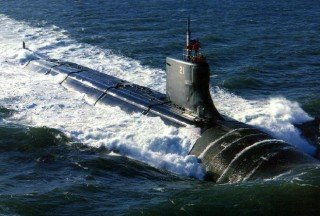
In doing so, though, Lieberman helped alienate his Democratic Party base in the state, losing his last party primary when he was up for re-election in November 2008, causing him to run successfully as an independent.
And Groton certainly lost its high-standing as a base when the Carter, the Navy’s leading stealth submarine, finally took off from there permanently in October for its new base with the Pacific Fleet at Bangor, Washington.
Then, Clark’s actual retirement services were even more embarrassing. On July 21st at the Naval Academy’s Alumni Hall, of all places, Rumseld laid out the changing of the guard at the CNO in every way that would ruffle Clark’s feathers.
“It is fitting we are here, in this special place in naval history,” the SOD addressed the onlookers, “to honor this officer who has led the Navy in historical times, as our country wages the global struggle against the enemies of freedom, the enemies of civilization.”
Then, instead of giving examples of how Clark had led the service in the fight, he went on about what everyone had been observing on the Academy’s grounds during the change-over weekend ceremonies.
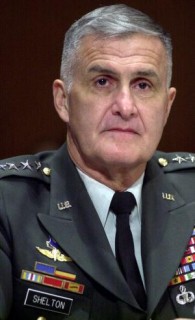
It was this unwillingness of Rumsfeld to speak candidly about Clark which intrigued Woodward to ask probing questions about his evaluation of him, and why he did not support his candidacy to become the Chairman of the Joint Chiefs after General Henry “Hugh” Shelton.
From the outset of becoming SOD, Rumsfeld made it crystal clear that he would be in charge of all serious matters at the Pentagon, as he explained to Shelton himself after having been in office only three short weeks:
” ‘I’m the secretary of defense,’ he said. ‘I’m in the chain of command.’ He – not the generals, not the Joint Staff – would deal with the White House and the president on operational matters.” (Quoted from Woodward, p. 22.)
Rumsfeld was obviously obsessed with the problems that his predecessor Caspar Weinberger had had with Navy Secretary Lehman, CNO Admiral James Watkins, and his successor Admiral Carlisle “Carl” Trost.
By then, Lehman thought he was the independent operational head of the Navy who was free to consult with the President when he wanted, and without either the permission or the knowledge of Weinberger.
To consolidate this hold over the Navy, Lehman got rid of all admirals who thwarted his ambitions and plans, that is until he ran up against Trost during the operations after the assassination of Sweden’s prime minister Olof Palme on February 28, 1986 – what Lehman had planned as his maritime strategy to get rid of the Soviet Union with a short, non-nuclear war.
The showdown between Lehman and Trost occurred twice in March 1986 when the admiral refused to back NATO’s Anchor Express Exercise across central Norway to the Kola Peninsula with his carrier battle groups in Operation Task Force Eagle.
In the process, many Norwegian engineers were killed in customary avalanches that the ill-informed planners had not anticipated, resulting in hectic negotiations by British SOD George Younger and others to arrange defensive maneuvers to cover the whole mess up. According to Lehman, Greg Vistica wrote in Fall From Glory, “The secretary of the Navy was king of the empire.” (p. 94)
When Lehman moved to continue the dangerous arrangements – what would have probably resulted in nuclear annihilation if the Soviets had not taken the necessary countermeasures to the Swedish surprise, thanks to the spying by Rick Ames, Robert Hanssen, and others – by replacing Watkins by toady Admiral Frank Kelso, Weinberger belatedly moved to replace Watkins with Trost, and see off Lehman in the process.
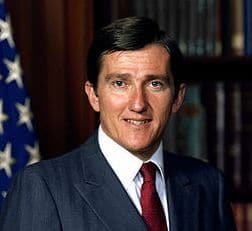
In the interim, Lehman had choice words for the seemingly mutinous Atlantic Fleet commander:
“You’re just another fucking Boy Scout.”
“You’re insufficiently compliant.” (Quoted from Vistica, p. 224.)
Rumsfeld wanted nothing of this from the likes of Clark, Wolfowitz, and others.
Of course, by this time, Wolfowitz had long departed the Pentagon as Deputy Secretary for the World Bank.
He had not only been too much a strategic supporter of Clark’s ambitions, but also the wild disinformation about the Indian Ocean tsunamis by Joe Vialls was starting to break down.
In the March-April 2005 issue of New Dawn Magazine, Jason Jeffrey had an updated version of his 1999 article, “Earthquakes: Natural or Man-Made?”
In it, he talked more about what could be done with compressed air, thanks to Nikola Tesla’s experiments, and spoke of “…a body of suppressed research pointing to a more insidious agenda” than what official explanations of the tsunamis were contending.
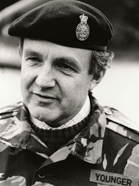
He concluded by mentioning the air guns that people were suggesting oil researchers were using in their searches for it.
On March 16, 2005, President Bush announced to the shocked international community that Wolfowitz had been nominated to replace Clinton appointee James D. Wolfensohn as head of the World Bank, citing his management of the Pentagon, and the fact that he was a decent man to justify the appointment.
It had been rumored for about two weeks but no one took it seriously because of the administration’s complaints about the Bank’s performance. It seems that the Jeffrey article had triggered rumor into reality.
When Clark finally left, the Navy lost its official capability to change the oceans and atmosphere at least for now, leaving the task again to the Air Force, as we shall see.
– End –
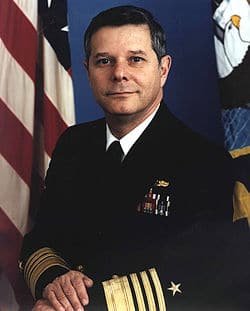
[Editor’s Note:] Admiral Mike Boorda was the only Chief of Naval Operations to have risen from the ranks. His suicide was a horrible tragedy for a family with two sons and a daughter-in-law as Naval Officers and three grandsons in the military.
The Staff of VT would like to extend our deepest sympathies to the Boorda extended family.
From Wikipedia:
Boorda died May 16, 1996 a suicide, having apparently shot himself in the chest.[9] The autopsy results were not released to the public.
He reportedly also left two suicide notes; neither was released publicly, but they were said to have been addressed to his wife and to his Public Information Officer.[10]
He was reported to have been disturbed over a news media investigation, led by David Hackworth of Newsweek, into Valor device enhancements he wore on his Navy Commendation Medal and Navy Achievement Medal (small bronze “V” devices, signifying valor in combat), which the media report claimed he was not entitled to wear.
He was said to be worried this issue would cause more trouble for the Navy’s reputation.

Former CNO Elmo Zumwalt, who was Boorda’s commander in Vietnam, wrote a letter to the effect that Boorda’s wearing of the devices was “appropriate, justified and proper.”[11]
Wearing a “V” to denote that a medal was awarded for in combat actions applied only to medals that could be awarded for meritorious service or for valor in combat (e.g. Bronze Star or Commendation Medal), as opposed to medals inherently distinguishing valor in combat (e.g. Silver Star and higher), and wearing the “V” device on the ribbon was not authorized unless the “V” device was specifically noted in the award citation.
Boorda was survived by his wife, Bettie Moran Boorda, four children, and 11 grandchildren.
In 1998, one of Boorda’s sons requested a review of his service record. The Board for Correction of Naval Records, the ultimate arbiter of whether Boorda was entitled to wear the Combat “V” on both medals, determined that he was not.[12]
Boorda’s headstone at Arlington National Cemetery located at Section 64, Lot 7101, Grid MM-17.

Trowbridge Ford (1929 – 2021) was the son of William Wallace Ford, the father of the US Army’s Grasshoppers.
He attended Phillips Exeter Academy, and Columbia University where he received a Ph.D. in political science after a stint in the Army’s Counter Intelligence Corps as a draftee during the Korean War, and after being discharged, worked as the sports editor and a reporter for the now-defunct Raleigh Times.
Thought academia was the thing for him. He was quite satisfied teaching all kinds of courses about European and American politics while writing his dissertation about an under-appreciated British politician, Henry Brougham, who became the Lord Chancellor of the famous Reform Government (1830-34).
At the same time, Trowbridge became most interested in the role that A. V. Dicey, a famous Oxford legal professor, played in settling the Irish question – another figure that historians didn’t think did much about. It was while he was doing research on the dissertation at the British Museum in London that President Kennedy was assassinated, and it slowly led him to take a dimmer view of academic life, especially when joined by campus protests over the growing Vietnam War. He was fired by two institutions of higher learning because of his protests against the war.
When the Vietnam War finally ended, he got involved in researching the Dallas assassination, and his first serious efforts about it appeared in Tom Valentine’s The National Exchange in 1978 – what Fletcher Prouty thought was quite good, just urging him to go higher in the Agency and the political world for the main culprits.
He slowly started doing this, ultimately deciding to retire early in 1986, planning on finishing his Brougham biography while living in Portugal. While he did this, he had made too many enemies with the White House not to be punished – first by attempts to establish that he maliciously tried to destroy Richard Nixon during Watergate by libeling him, and when he died, DCI George Tenet tried to have me killed by poisoning – what would make his death look like a suicide or a natural one.
As a result of this, once he had finally determined the cause, he moved to Sweden to not only save his skin but also investigate and write about assassinations, covert operations, ‘false flag’ deceptions, preventive wars, weapons development, and their use, etc. He passed away in 2021.
ATTENTION READERS
We See The World From All Sides and Want YOU To Be Fully InformedIn fact, intentional disinformation is a disgraceful scourge in media today. So to assuage any possible errant incorrect information posted herein, we strongly encourage you to seek corroboration from other non-VT sources before forming an educated opinion.
About VT - Policies & Disclosures - Comment Policy




